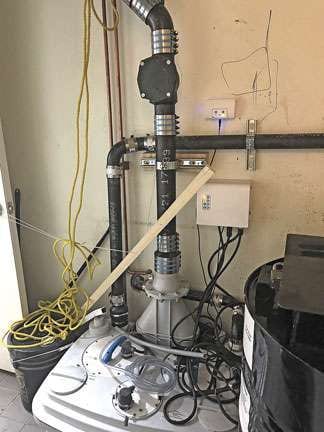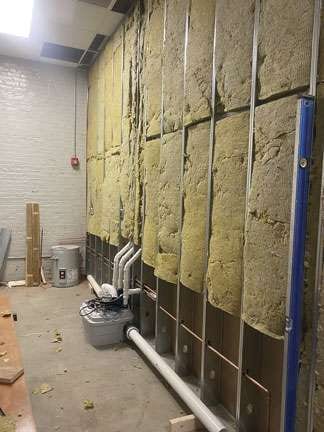The pitfalls of breaking through concrete
Grinder pump systems offer an alternative for commercial establishments.
By Michael Cerna
Above-floor plumbing technology eliminates potential problems related to breaking through concrete.
No doubt, it’s a scenario you have encountered — and successfully managed — on any number of occasions: A building owner wants restroom facilities or a commercial kitchen space where plumbing does not exist, or the nearest plumbing line is 10 or more feet away. So he or she asks you for an inspection, an assessment and a quote. The space happens to be on a second level, or in a basement, on a slab.
In any event, to create below-floor drainage with either conventional plumbing or sewage ejection, you immediately conclude that you must pound through concrete. That means a messy, noisy, time-consuming job — and a high cost. So high, in fact, that when your customer sees your estimate, chances are, they’ll tell you to forget it.
As a plumbing industry professional, you may find digging through concrete as simply one of the hazards of your trade. Or maybe not. But, chances are, you do see it as an everyday part of making a living in the business. If a customer doesn’t want to deal with the hassles, that’s fine: You just move on to the next job.
Luckily, an above-floor drain pump system is an effective, cost-efficient alternative to time-consuming, labor-intensive trenching. Grinder plumbing systems offer convenience and cost-saving benefits. Unfortunately, when confronted with the above scenario, too many plumbers and engineers fail to consider the above-floor option, probably because they haven’t yet tried it.
But even if you don’t know much about above-floor plumbing technology, we would still urge you not to discount the pitfalls of busting through concrete floors. There are some truly sobering hazards to ponder before subjecting your customer to them.
Below we enumerate the most important of those hazards. Before you proceed on your next floor-busting project, you may want to sit down with your customer to discuss each of these potential problems in depth, then consider an alternative approach.
After Revival Brewery Company reopened the brewpub in a new building, the owners had various projects lined up to improve the space, including additional bathrooms and a new bar area. They had originally planned to install traditional underground drain lines, but later realized the concrete was three feet thick, making any new plumbing installation particularly difficult and expensive. Thankfully, O'Leary knew of Saniflo’s above-floor plumbing solution, because he had been using it over the entire span of his 20-year plumbing career.


Red flags to remember
Cutting concrete undermines structural integrity: Any time you cut into a slab, you decrease the foundational integrity of the building — no matter how close to a perfect cut you make. You may be able to patch the hole you create well enough to eliminate any aesthetic objections from your customer. But is that floor as solid as it was before you began to cut? We would bet not — especially if you fail to use the same or a better grade of concrete. And if the building sits on ground that’s less than solid, such as sand, it may begin to settle differently after the cut.
In a multi-floor building, cutting into a slab on the second, third or fourth levels to run plumbing beneath the floor would be a huge no-no. That’s why commercial-renovation projects that require additional plumbing will typically use external soil stacks, putting the external plumbing tree on the outside of the building. Well, if you shouldn’t cut into any of the upper levels of a building, why would you think you could safely cut into the first level — the slab on which everything else sits?
Cutting concrete is unpredictable: Installers don’t always know the depth of the concrete, whether it sits on rocks or a ledge, or whether it contains rebar or tension cables. You can cause major damage if you accidentally cut one of those cables. Professional contractors understand this hazard and never begin cutting without first using an x-ray machine to determine the positioning of the cables.
But even then, the slab was most likely designed to use a certain number of cables with a certain amount of concrete. If you begin removing chunks of concrete, those tension wires may begin pulling in a different direction, creating integrity problems and causing delays and extra expense.
Cutting concrete is seldom, if ever, perfect: You may try as hard as you can to cut a perfect circle, square or rectangle into a floor for burying a sewage ejector and its waste-storage basin — but no way. That “perfect” shape will inevitably crack on the edges and fray outward in unintended directions, often well beyond the hole you’re digging. And once a stress crack is created, how far down does it extend into the footing or into the walls?
Cutting concrete creates leaks and seepage: Once a stress crack is generated, radon and ground-water penetration is a major issue, with the latter bringing unwanted moisture and mold problems as well. You don’t need a major flood to trigger these hazards. A higher-than-usual water table because of extended wet weather, such as in the spring, could be the culprit. Even if the cracks and seepage are not large enough to jeopardize the foundation, enough wetness could infiltrate to ruin walls, floors and furnishings in a finished living area — including that beautiful new bathroom that necessitated digging through the concrete in the first place.
Cost factors: Lastly, but certainly not least, there’s the problem we mentioned at the outset of this article, the one that often proves to be the biggest deal-breaker of all — cost. The actual expense of cutting concrete depends on the size and complexity of the job, as well as local labor availability and rates. In some parts of the nation, the per-foot rate may be $1,000 or more.
Seeing these costs, some plumbers outsource the work and are content to make little or no markup on their sub’s charges. Others, preferring to keep the job in-house, absorb the time and cost of renting the cutting and hammering tools and lugging them on and off the job site; or, if they choose to buy, the cost of maintaining and replacing these tools, as well as depreciation.
Perhaps the biggest and most painful expense of all is the “lost-opportunity” cost. With above-floor plumbing, creating a new bathroom or kitchen where none exists usually takes a day, maybe two at most, to install the basic plumbing. Go the busting-through-concrete route and you’ll be on the job triple or quadruple that amount of time and likely more. What other work could you be doing all those extra days — more profitable work that you like much better and are really good at — instead of wrestling with broken concrete and all the hassles it brings?
Grinder pump systems as an alternative
No doubt, installing conventional plumbing requires major construction. In fact, based on the pitfalls shared above, it could be even more expensive and complicated if your customer’s space is in an older building or a high-rise, where it's difficult to change the plumbing infrastructure.
Let’s take a closer look at grinder pump systems as an effective, cost-efficient alternative to trenching.
Pre-assembled grinding pump systems are capable of discharging wastewater from multiple fixtures. No matter how big your project is, for commercial or residential purposes, above or below ground, one or two motors, a grinder pump offers a cost-effective alternative to trenching.
Real-world applications
Take Revival Brewery Company as an example. After reopening the brewpub in a new building, the owners had various projects lined up to improve the space, including additional bathrooms and a new bar area.
However, the brewery's new location posed a difficult plumbing situation. According to Geoff O'Leary, owner of O'Leary Plumbing & Heating, they had originally planned to install traditional underground drain lines, but "during the initial construction of the brewery, they utilized a space without any plumbing plans available, so we had no idea what the plumbing setup looked like," explains O'Leary.
"We knew there were drain lines in the floor, but we didn't know where we wanted to install the restrooms and new bar area," he continues. "We later realized the concrete was three feet thick, making any new plumbing installation particularly difficult and expensive."
Thankfully, O'Leary knew of Saniflo’s above-floor plumbing solution, because he had been using it over the entire span of his 20-year plumbing career. He knew Saniflo’s grinder pump system would allow them to install plumbing without needing to break through that 3-inch thick concrete to install new drain lines. After learning more about Saniflo's Sanicubic 2 Grinder Pump System, O'Leary decided it would solve the brewery's concrete trenching issues.
"The Sanicubic set the standard for the brewery and helped out tremendously because we could go from one staff bathroom to providing two bathrooms for the public," O'Leary explains. Read the complete case study here.
Another great example is the venerable Ipanema Restaurant in midtown Manhattan’s recent renovation of its two-floor space on 36th Street. New restrooms were an important part of the modernization: New men’s and women’s facilities on the main floor for the clientele, plus a third and separate private bathroom for the Ipanema staff. The location for the latter was a former employee locker room one floor below the restaurant in the basement.
Rather than installing conventional below-floor drainage for a staff washroom, mechanical contractor SNC Mechanical opted for a Sanicubic 2 VX Pump System, saving the owners of a midtown Manhattan restaurant roughly $6,000 by avoiding the need to break through concrete. Read the complete case study here.
Next time you have the “opportunity” to bust through a concrete floor to run piping or bury an ejector pump, we hope you’ll take a few minutes to recall the red flags associated and the much more convenient alternative. Why keep doing things The Old School Way when there’s an easier and less expensive alternative that will leave your customer happier and your bank account fuller?
Michael Cerna, assistant technical manager at SFA Saniflo, has worked for the company for more than nine years. Cerna has been involved in many commercial projects where he has done site visits to verify installation and provide feedback on alternative solutions as well as sizing out pumps with engineers and architects. He has elevated his knowledge to become an all-around technical asset within Saniflo and has contributed to the overall success of the company.

